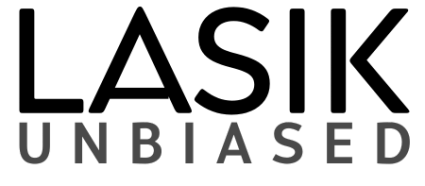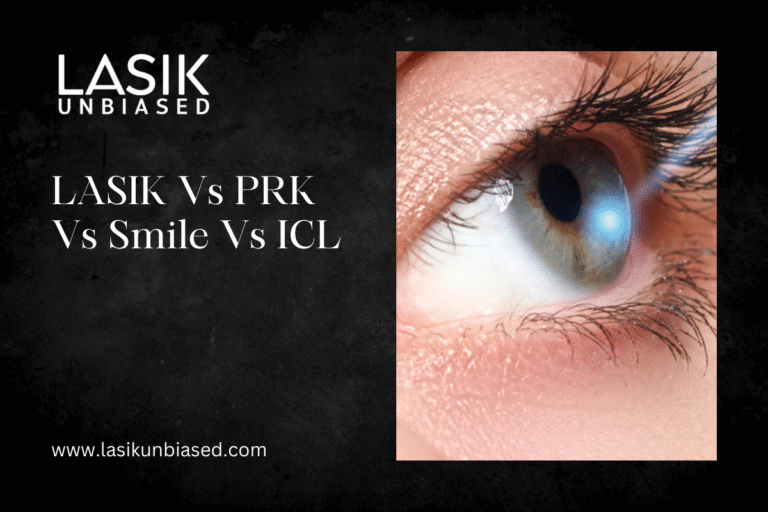If you’re considering vision correction surgery but unsure which procedure to choose, LASIK, PRK, SMILE, and ICL are four of the most common options.
Each has its own benefits, recovery process, and suitability factors, depending on your unique vision needs. This in-depth guide will help you compare and understand these procedures, so you can make an informed decision with your doctor.
What are LASIK, PRK, SMILE, and ICL?
Before we get into comparisons, here’s a brief overview of what each procedure entails:
- LASIK (Laser-Assisted in Situ Keratomileusis): A laser is utilised to reshape the cornea beneath a thin flap, effectively correcting refractive errors.
- PRK (Photorefractive Keratectomy): The top layer of the cornea is removed entirely before reshaping, without creating a flap.
- SMILE (Small Incision Lenticule Extraction): A minimally invasive procedure involving the removal of a small disc of corneal tissue through a precise incision.
- ICL (Implantable Collamer Lenses): In contrast to laser-based procedures, Implantable Collamer Lens (ICL) surgery involves the insertion of a corrective lens into the eye without modifying the cornea.
Each procedure addresses common refractive errors such as nearsightedness, farsightedness, and astigmatism, but their methods and recovery processes vary. Below, we’ll break this down further.
Key Differences Between LASIK, PRK, SMILE, and ICL
The Surgical Process
- LASIK:
- A thin corneal flap is created by the surgeon using either a microkeratome blade or a femtosecond laser.
- The cornea is carefully reshaped using an excimer laser to enhance visual focus.
- The corneal flap is then repositioned to facilitate natural healing.
- Key Benefit: Quick procedure and minimal discomfort.
- PRK:
- The outer epithelial layer of the cornea is meticulously removed.
- The cornea is subsequently reshaped utilizing an excimer laser.
- A bandage contact lens is applied to assist healing.
- Key Benefit: Ideal for patients with thin corneas.
- SMILE:
- A small lenticule of corneal tissue is generated using a femtosecond laser.
- This lenticule is extracted through a minimal incision, resulting in the reshaping of the cornea.
- Key Benefit: No flap required; minimally invasive.
- ICL:
- A collamer lens is surgically implanted posterior to the iris and anterior to the natural lens.
- It does not require any corneal reshaping or removal of tissue.
- Key Benefit: Reversible option with high-quality optics.
Recovery Time and Discomfort
- LASIK:
- Recovery is fast, with many patients achieving improved vision within 24 hours.
- Slight dryness and irritation are common but resolve quickly.
- PRK:
- Recovery takes longer (up to a week) as the epithelial layer regenerates.
- Patients may experience more discomfort, light sensitivity, and blurred vision during this period.
- SMILE:
- Patients typically recover within 24-48 hours.
- The minimally invasive nature reduces dryness and discomfort compared to LASIK.
- ICL:
- Recovery is relatively quick, with many patients noticing improved vision within 1–2 days.
- No corneal healing means discomfort is minimal.
Eligibility and Suitability
LASIK: Suitable for most patients with stable prescriptions, provided they have sufficient corneal thickness. However, those with thin or irregular corneas may not qualify.
PRK: Appropriate for individuals with thinner corneas or those prone to dry eyes, as it avoids flap creation.
SMILE: Ideal for individuals with myopia, astigmatism, hyperopia, or those seeking a minimally invasive treatment option.
ICL: Ideal for individuals with high prescriptions or thin corneas, as it doesn’t involve reshaping the cornea. It’s also a great option for those who want a reversible procedure.
Longevity and Adjustments
- LASIK, PRK, and SMILE: These are permanent procedures, although vision may change naturally with age (e.g., presbyopia). Minor adjustments can sometimes be made with enhancement surgeries.
- ICL: Provides flexibility, as the lens can be replaced or removed if needed.
Risks and Considerations
- LASIK and PRK: There is a potential risk of experiencing dry eyes, glare, or halos around lights at night, particularly in the period immediately following the procedure.
- SMILE: Risks are generally lower due to the minimally invasive method, but may include temporary glare or blurriness.
- ICL: Risks include cataract formation, elevated intraocular pressure, infection, or lens-related complications, though complications are rare with skilled surgeons.
Cost Comparison
While prices vary significantly depending on location, surgeon experience, and what’s included in the package (e.g., pre-op exams, post-op care), here’s a general breakdown:
- LASIK: INR 50,000 to INR 1,30,000 for both eyes.
- PRK: Similar to LASIK, around INR 40,000 to 80,000 for both eyes.
- SMILE: Slightly higher cost, averaging INR 1,00,000 to 1,50,000 for both eyes.
- ICL: The most expensive, typically ranging from INR 1,30,000 to INR 2,20,000 for both eyes, due to lens manufacturing.
Comparison Table
| Procedure | Surgical Approach | Recovery Time | Suitability | Average Cost (for both eyes) |
| LASIK | Flap creation and corneal reshaping | 1–2 days | General candidates with thick corneas | INR 50,000 to INR 1,30,000 |
| PRK | Epithelial removal and reshaping | 5–10 days | Thin corneas and dry eye sufferers | INR 40,000 to 80,000 |
| SMILE | Minimally invasive lenticule removal | 1-2 days | Minimally invasive seekers | INR 1,00,000 to 1,50,000 |
| ICL | Lens insertion behind the iris | 1–2 days | High prescriptions or thin corneas | INR 1,30,000 to INR 2,20,000 |
Which Vision Correction Procedure is Right for You?
Your choice depends on several factors, including your lifestyle, eye health, and budget. It’s always best to consult an experienced ophthalmologist or optometrist to discuss your unique needs.
- Choose LASIK if you want a fast recovery and are eligible based on corneal thickness.
- Opt for PRK if you have thin corneas or suffer from dry eyes.
- Consider SMILE if you want a less invasive option for myopia, astigmatism, or hyperopia correction.
- Go with ICL if you need a reversible procedure or have very high prescriptions.
Take the Next Step Towards Clear Vision
Finding the right vision correction method can feel overwhelming, but the guidance of a trusted eye care professional can make all the difference. Remember, every eye is different, and what works for one person might not work for another.
Considering LASIK, PRK, SMILE, or ICL?
Book a consultation today to learn which one suits your vision needs best. Clear vision is just around the corner.


